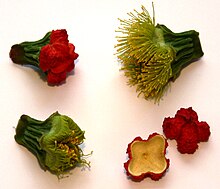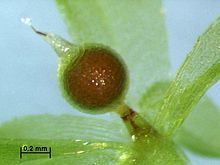Operculum (botany)




Inbotany,anoperculum(pl.:opercula) orcalyptra(fromAncient Greekκαλύπτρα(kalúptra)'veil') is a cap-like structure in someflowering plants,mosses,andfungi.It is a covering, hood or lid, describing a feature inplant morphology.
Flowering plants
[edit]In flowering plants, the operculum, also known as a calyptra, is the cap-like covering or "lid" of the flower or fruit that detaches at maturity. The operculum is formed by the fusion ofsepalsand/orpetalsand is usually shed as a single structure as the flower or fruit matures.[1]The name is also used for the capping tissue ofroots,theroot cap.
Ineucalypts,(includingEucalyptusandCorymbiabut notAngophora) there may be two opercula – an outer operculum formed by the fusion of the united sepals and an inner operculum formed by the fusion of the sepals. In that case, the outer operculum is shed early in the development of the bud leaving a scar around the bud. In those species that lack an outer operculum, there is no bud scar. The inner operculum is shed just before flowering, when thestamensexpand and shed theirpollen.[2]
In some species ofmonocotyledon,the operculum is an area ofexinecovering the pollen aperture.[3]
InPlantago,thecapsulehas an opening covered by an operculum. When the operculum falls, the seed is sticky and is easily carried by animals that come into contact with it.[4]
Pitcher plantshave an operculum above the pitcher that serves to keep out rainwater that would otherwise dilute the digestive juices in the pitcher.[5]
Bryophytes
[edit]Inbryophytes,thecalyptra(pluralcalyptrae) is an enlargedarchegonialventer that protects the capsule containing the embryonicsporophyte.[6]The calyptra is usually lost before the spores are released from the capsule. The shape of the calyptra can be used for identification purposes.[7]
Thesporangiumof mosses usually opens when its operculum or "lid" falls off, exposing a ring of teeth that control the release of spores.[8]
Fungi
[edit]There are two types of sexual spore-bearingasciofascomycetefungi– those that have an operculum at the top of the ascus, and those that do not.[9]
See also
[edit]References
[edit]- ^"Glossary of Botanical Terms".Royal Botanic Garden Sydney.Retrieved27 December2019.
- ^"Learn about eucalypts".Euclid: Centre for Australian National Biodiversity Research.Retrieved27 December2019.
- ^Furness, Carol A.;Rudall, Paula J.(January 2001)."Pollen and anther characters in monocot systematics".Grana.40(1–2): 17–25.doi:10.1080/00173130152591840.
- ^Kuiper, Pieter J.C.; Bos, Marten; Soekarjo, R., eds. (1992).Plantago:A multidisciplinary study.Berlin: Springer-Verlag. pp. 6–12.ISBN3540536329.
- ^"The giant plants that eat meat".BBC.Retrieved27 December2019.
- ^Ralf Reski(1998): Development, genetics and molecular biology of mosses. In: Botanica Acta. 111, 1-15.
- ^Malcolm; Malcolm, Bill; Nancy (2006),Mosses and other Bryophytes, an Illustrated Glossary,Micro-Optics Press, p. 65,ISBN0-9582224-7-9
{{citation}}:CS1 maint: multiple names: authors list (link) - ^"Form and function".Encyclopædia Britannica, Inc.Retrieved27 December2019.
- ^Reynolds, Don R.; van Brummelen, J. (1981).Ascomycete Systematics: the Luttrellian Concept (Chapter 3 - The Operculate Ascus and Allied Forms).New York: Springer-Verlag. pp. 27–31.ISBN9781461258469.
External links
[edit]- ..1914.
